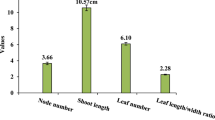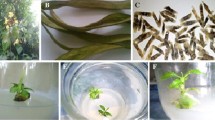Abstract
The study was conducted to evaluate the effects of 10 and 20 min seed soaking in Azotobacter chroococcum and Bacillus polymixa suspension culture on seed germination, seedling growth and essential oil yield of Dracocephalum kotschyi Boiss. Up to day 13, 20 min of B. polymixa suspension culture soaking seeds had shown germination more than 20%, whereas control seeds did not begin germination until day 13. The highest germination rate (1.67) was observed with 20 min of B. polymixa suspension culture soaking seeds. B. polymixa improved seedling length and vigour index more than those of A. chroococcum suspension culture soaking seeds. The highest fresh (81.06 g) and dry weight (11.76 g), relative leaf chlorophyll content (42.24) and Fv/Fm ratio (0.66) of emerging D. Kotschyi seedlings were recorded with seed bio-priming with B. polymixa for 20 min. The main components affected by B. polymixa and A. chroococcum were limonene, α‑pinene, γ‑terpinene, caryophyllene oxide, germacrene D and terpinen-4-ol. The highest percentage of essential oil constituents (97.6%) of D. Kotschyi seedlings were observed with 20 min of B. polymixa suspension culture soaking seeds. The results indicated that seed bio-priming with B. polymixa for 20 min was more effective than the other treatments concerning seed germination, seedling growth and essential oil yield of D. Kotschyi.
Zusammenfassung
Die Studie wurde durchgeführt, um die Auswirkungen eines 10- und 20-minütigen Einweichens von Dracocephalum-kotschyi-Boiss-Saatgut in einer Azotobacter-chroococcum- und Bacillus-polymixa-Suspensionskultur auf die Samenkeimung, das Keimlingswachstum und die Ausbeute an ätherischem Öl zu bewerten. Bis zum Tag 13 hatten die Samen, die 20 min in der B.-polymixa-Suspensionskultur eingeweicht worden waren, eine Keimung von mehr als 20 % gezeigt, während Kontrollsamen erst am Tag 13 mit der Keimung begannen. Die höchste Keimungsrate (1,67) wurde beim 20-minütigen Einweichen in der B.-polymixa-Suspensionskultur beobachtet. Das Einweichen in einer B.-polymixa-Suspensionskultur hatte einen positiveren Einfluss auf die Keimlingslänge und den Vitalitätsindex als das Einweichen in einer A.-chroococcum-Suspensionskultur. Die höchsten Werte für das Frisch- (81,06g) und Trockengewicht (11,76 g), den relativen Blattchlorophyllgehalt (42,24) und das Fv/Fm-Verhältnis (0,66) der D.-Kotschyi-Sämlinge wurden mit Saatgut-Bio-Priming mit B. polymixa für 20 min erreicht. Die von der Behandlung mit B. polymixa und A. chroococcum betroffenen Hauptkomponenten waren Limonen, α‑Pinen, γ‑Terpinen, Caryophyllenoxid, Germacren D und Terpinen-4-ol. Der höchste Anteil an ätherischen Ölbestandteilen (97,6 %) von D.-Kotschyi-Keimlingen wurde beim 20-minütigen Einweichen in der B.-polymixa-Suspensionskultur beobachtet. Die Ergebnisse zeigten, dass die Saatgutvorbereitung mit B. polymixa für 20 min bezüglich Saatgutkeimung, Keimlingswachstum und ätherischer Ölausbeute von D. Kotschyi wirksamer war als die anderen Behandlungen.







Similar content being viewed by others
References
Abuamsha R, Salman M, Ehlers R (2011) Effect of seed priming with Serratia plymuthica and Pseudomonas chlororaphis to control Leptosphaeria maculans in different oilseed rape cultivars. Eur J Plant Pathol 130:287–295. https://doi.org/10.1007/s10658-011-9753-y
Amirghofran Z, Azadbakht M, Karimi MH (2000) Evaluation of the immunomodulatory effects of five herbal plants. J Ethnopharmacol 72:167–172
Ananthi M, Selvaraju P, Sundaralingam K (2014) Effect of bio-priming using bio-control agents on seed germination and seedling vigour in chili (Capsicum annuum L.) ‘PKM 1’. J Hortic Sci Biotechnol 89(5):564–568. https://doi.org/10.1080/14620316.2014.11513121
Banchio E, Bogino PC, Zygadlo J, Giordano W (2008) Plant growth promoting rhizobacteria improve growth and essential oil yield in Origanum majorana L. Biochem System Ecol 36:766–771. https://doi.org/10.1016/j.bse.2008.08.006
Banchio E, Xie X, Zhang H, Pare PW (2009) Soil bacteria elevate essential oil accumulation and emissions in sweet basil. J Agric Food Chem 57:653–657. https://doi.org/10.1021/jf8020305
Del Giudice L, Massardo DR, Pontieri P, Bertea CM, Tredici SM, Tala A, Mucciarelli M, Groudeva VI, De Stefano M, Vigliotta G, Maffei ME, Alifano P (2008) The microbial community of Vetiver root and its involvement into essential oil biogenesis. Environ Microbiol 10:2824–2841. https://doi.org/10.1111/j.1462-2920.2008.01703.x
Delshadi S, Ebrahimi M, Shirmohammadi E (2017) Influence of plant-growth—Promoting bacteria on germination, growth and nutrient uptake of Onobrychis sativa L., under drought stress. J Plant Interact 12(1):200–208. https://doi.org/10.1080/17429145.2017.1316527
Dharni S, Srivastava AK, Samad A, Patra DD (2014) Impact of plant growth promoting Pseudomonas monteilii PsF84 and Pseudomonas plecoglossicida PsF610 on metal uptake and production of secondary metabolite (monoterpenes) by rose-scented geranium (Pelargonium graveolens cv. bourbon) grown on tannery sludge amended soil. Chemosphere 117:433–439. https://doi.org/10.1016/j.chemosphere.2014.08.001
Ellis RH, Roberts EH (1981) The quantification of ageing and survival in orthodox seeds. Seed Sci Technol 9:373–409
Fattahi M, Nazeri V, Sefidkon F, Zamani Z, Palazon J (2011) The effect of pre-sowing treatments and light on seed germination of Dracocephalum kotschyi Boiss: An endangered medicinal plant in Iran. Hortic Environ Biotechnol 52(6):559–566. https://doi.org/10.1007/s13580-011-0057-0
Ghahreman A (1983) Flora of Iran. Research Institute of Forests and Rangelands Publications, Tehran, p 432
Glick BR, Cheng Z, Czarny J, Cheng Z, Duan J (2007) Promotion of plant growth by ACC-deaminase-producing soil bacteria. Eur J Plant Pathol 119:329–339. https://doi.org/10.1007/s10658-007-9162-4
Gohari AR, Saeidnia S, Matsuo K, Uchiyama N, Yagura T, Ito M, Kiuchi F, Honda G (2003) Flavonoid constituents of Dracocephalum kotschyi growing in Iran and their trypanocidal activity. J Nat Med 57:250–252
Golshani S, Karamkhani F, Monsef-Esfehani HR, Abdollahi M (2004) Antinociceptive ffects of the essential oil of Dracocephalum kotschyi in the mouse writhing test. J Pharm Pharm Sci 7:76–79
Han QQ, Lu XP, Bai JP, Qiao Y, Pare PW, Wang SM, Zhang JL, Wu YN, Pang XP, Xu WB, Wang ZL (2014) Beneficial soil bacterium Bacillus subtilis (GB03) augments salt tolerance of white clover. Front Plant Sci 5:1–7. https://doi.org/10.3389/fpls.2014.00525
Harvey PR, Warren RA, Wakelin S (2009) Potential to improve root access to phosphorus: The role of non-symbiotic microbial inoculants in the rhizosphere. Crop Pasture Sci 60:144–151. https://doi.org/10.1071/CP08084
Jahaniani F, Ebrahimi SA, Rahbar-Roshandel N, Mahmoudian M (2005) Xanthomicrol is the main cytotoxic component of Dracocephalum kotschyii and a potential anti-cancer agent. Phytochemistry 66:1592–1581. https://doi.org/10.1016/j.phytochem.2005.04.035
Jalali A, Jamzad Z (1999) Red data book of Iran. Research Institute of Forests and Rangelands Iran, Tehran, p 748
Javidnia K, Miri R, Fahham N (2005) Composition of the essential oil of Dracocephalum kotschyi Boiss., from Iran. J Essent Oil Res 17:481–482. https://doi.org/10.1080/10412905.2005.9698970
Kloepper JW, Zablowicz RM, Tipping B, Lifshitz R (1991) Plant growth mediated by bacterial rhizosphere colonizers. In: Keister DL, Gregan B (Eds.) The rhizosphere and plant growth. BARC Symp. 14: 315–326
Kloepper JW, Ryu CM, Zhang S (2004) Induced systemic resistance and promotion of plant growth by Bacillus spp. Phytopathology 94:1259–1266. https://doi.org/10.1094/PHYTO.2004.94.11.1259
Lenin G, Jayanthi M (2012) Efficiency of plant growth promoting rhizobacteria (PGPR) on enhancement of growth, yield and nutrient content of Catharanthus roseus. Int J Res Pure Appl Microbiol 2:37–42
Mahmood A, Turgay OC, Farooq M, Hayat R (2016) Seed biopriming with plant growth promoting rhizobacteria: A review. FEMS Microbiol Ecol 92(8):1–14. https://doi.org/10.1093/femsec/fiw112
Moghaddam G, Ebrahimi SA, Rahbar-Roshandel N, Foroumadi A (2012) Antiproliferative activity of flavonoids: Influence of the sequential methoxylation state of the flavonoid structure. Phytother Res 26:1023–1028. https://doi.org/10.1002/ptr.3678
Moradi Dezfuli P, Sharif-Zadeh F, Janmohammadi M (2008) Influence of priming techniques on seed germination behavior of maize inbred lines (Zea mays L.). J Agric Biol Sci 3:22–25
Mozaffarian V (1998) A dictionary of Iranian plants names. Farhang Moaser, Tehran, pp 192–193
Nadjafi F, Bannayan M, Tabrizi L, Rastgoo M (2006) Seed germination and dormancy breaking techniques for Ferula gummosa and Teucrium polium. J Arid Environ 64:542–547. https://doi.org/10.1016/j.jaridenv.2005.06.009
Nadjafi F, Mahdavi Damghani M, Tabrizi L, Nejad Ebrahimi S (2014) Effect of biofertilizers on growth, yield and essential oil content of thyme (Thymus vulgaris L.) and sage (Salvia officinalis L.). J Essent Oil Bear Plants 17(2):237–250. https://doi.org/10.1080/0972060X.2013.813235
Nuncio-Orta G, Mendoza-Villarreal R, Robledo-Torres V, Vazquez- Badillo M, Almaraz Suarez JJ (2015) Influence of rhizobacteria on seed germination and vigor of seeds chili jalapeno (Capsicum annuum L. ‘var. Grande’). ITEA 111:18–33
Pare PW, Zhang HM, Aziz M, Xie XT, Kim MS, Shen X, Zhang JL (2011) Beneficial rhizobacteria induce plant growth: Mapping signaling networks in Arabidopsis. In: Witzany BG (ed) Biocommunication in soil microorganisms. Soil biology, vol 23. Springer, Dordrecht, pp 403–412 https://doi.org/10.1007/978-3-642-14512-4_15 (Chapter. 15.)
Ramamoorthy V, Viswanathan R, Raghuchander T, Prakasam Samiyappan TR (2001) Induction of systemic resistance by plant growth promoting rhizobacteria in crop plants against pests and diseases. Crop Protect 20:1–11. https://doi.org/10.1016/S0261-2194(00)00056-9
Rechinger KH (1986) Labiatae. In: Rechinger KH, Hedge IC (eds) Flora Iranica, vol 150. Akademische Druck Verlagsantalt, Graz, pp 218–231
Saeidnia S, Gohari AR, Uchiyama N, Ito M, Honda G, Kiuchi F (2004) Two new monoterpene glycosides and trypanocidal terpenoids from Dracocephalum kotschyi. Chem Pharm Bull 52:1249–1250
Sangwan NS, Farooqi AHA, Shabih F, Sangwan RS (2001) Regulation of essential oil production in plants. Plant Growth Regul 34:3–21. https://doi.org/10.1023/A:1013386921596
Shaukat K, Affrasayab S, Hasnain S (2006) Growth responses of Helianthus annus to plant growth promoting rhizobacteria used as a biofertilizer. J Agric Res 1:573–581. https://doi.org/10.3923/ijar.2006.573.581
Somova LA, Pechurkin NS, Sarangova AB, Pisman TI (2001) Effect of bacterial population density on germination wheat seeds and dynamics of simple artificial ecosystems. Adv Space Res 27(9):1611–1615. https://doi.org/10.1016/S0273-1177(01)00257-5
Srivastava R, Khalid AU, Singh S, Sharma AK (2010) Evaluation of arbuscular mycorrhizal fungus, fluorescent Pseudomonas and Trichoderma harzianum formulation against Fusarium oxysporum for the management of tomato wilt. Biol Control 53:24–31. https://doi.org/10.1016/j.biocontrol.2009.11.012
Takano T (1993) Germination characteristics of herbs in Labiatae. Acta Hortic 331:275–268
Thanos CA, Kadis CC, Skarou F (1995) Ecophysiology of germination in the aromatic plants thyme, savory and oregano (Labiatae). Seed Sci Res 5(30):161–170
Tiwari P, Singh JS (2017) A plant growth promoting rhizospheric Pseudomonas aeruginosa strain inhibits seed germination in Triticum aestivum (L) and Zea mays (L). Microbiol Res (Pavia) 8(2):1–7. https://doi.org/10.4081/mr.2017.7233
Veldhuizen V, Knight C (2006) Dragonhead mint (Dracocephalum parviflorum Nutt.) as potential agronomic crop for Alaska. AFES, Fairbanks, pp 1–12
Wicaksono WA, Jones EE, Sansom CE, Perry NB, Monk J, Black A, Ridgway HJ (2017) Indigenous bacteria enhance growth and modify essential oil content in Leptospermum scoparium (manuka). NZ J Bot 55(3):306–317. https://doi.org/10.1080/0028825X.2017.1330272
Wiese AM, Binning LK (1987) Calculating the threshold temperature of development for weeds. Weed Sci 35:177–179. https://doi.org/10.1017/S0043174500079017
Wu YN, Feng YL, Pare PW, Chen YL, Xu R, Wu S, Wang SM, Zhao Q, Li HR, Wang YQ, Zhang JL (2016) Beneficial soil microbe promotes seed germination, plant growth and photosynthesis in herbal crop Codonopsis pilosula. Crop Pasture Sci 67(1):91–98. https://doi.org/10.1071/CP15110
Xie X, Zhang H, Pare PW (2009) Sustained growth promotion in Arabidopsis with long-term exposure to the beneficial soil bacterium Bacillus subtilis (GB03). Plant Signal Behav 4:948–953
Zablotowicz RM, Tipping EM, Lifshitz R, Kloepper JW (1991) Plant growth promotion mediated by bacterial rhizosphere colonizers. In: Keister DL, Cregan PB (eds) The rhizosphere and plant growth. Beltsville symposia in agricultural research, vol 14. Springer, Dordrecht, pp 315–326 https://doi.org/10.1007/978-94-011-3336-4_70
Zahir ZA, Arshad M, Frankenberger WT (2004) Plant growth promoting rhizobacteria: applications and perspectives in agriculture. Adv Agron 81:96–168
Zhang H, Sun Y, Xie X, Kim MS, Dowd SE, Pare PW (2009) A soil bacterium regulates plant acquisition of iron via deficiency-inducible mechanisms. Plant J 58:568–577. https://doi.org/10.1111/j.1365-313X.2009.03803.x
Zhang H, Xie X, Kim MS, Kornyeyev DA, Holaday S, Pare PW (2008) Soil bacteria augment Arabidopsis photosynthesis by decreasing glucose sensing and abscisic acid levels in planta. Plant J 56:264–273. https://doi.org/10.1111/j.1365-313X.2008.03593.x
Zhang JL, Aziz M, Qiao Y, Han QQ, Li J, Wang YQ, Shen X, Wang SM, Pare PW (2014) Soil microbe Bacillus subtilis (GB03) induces biomass accumulation and salt tolerance with lower sodium accumulation in wheat. Crop Pasture Sci 65:423–427. https://doi.org/10.1071/CP13456
Acknowledgements
This research did not receive any specific grant from funding agencies in the public, commercial, or not-for-profit sectors. However, we would like to thank the College of Agriculture, Isfahan University of Technology for the support to conduct this study and the colleagues who helped us during the experimental work.
Author information
Authors and Affiliations
Corresponding author
Ethics declarations
Conflict of interest
S.S. Bidabadi and M. Mehralian declare that they have no competing interests.
Rights and permissions
About this article
Cite this article
Bidabadi, S.S., Mehralian, M. Seed Bio-priming to Improve Germination, Seedling Growth and Essential Oil Yield of Dracocephalum Kotschyi Boiss, an Endangered Medicinal Plant in Iran. Gesunde Pflanzen 72, 17–27 (2020). https://doi.org/10.1007/s10343-019-00478-2
Received:
Accepted:
Published:
Issue Date:
DOI: https://doi.org/10.1007/s10343-019-00478-2




